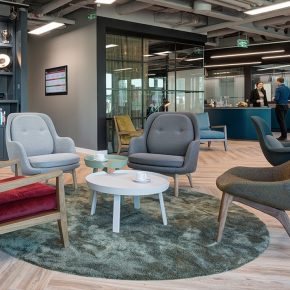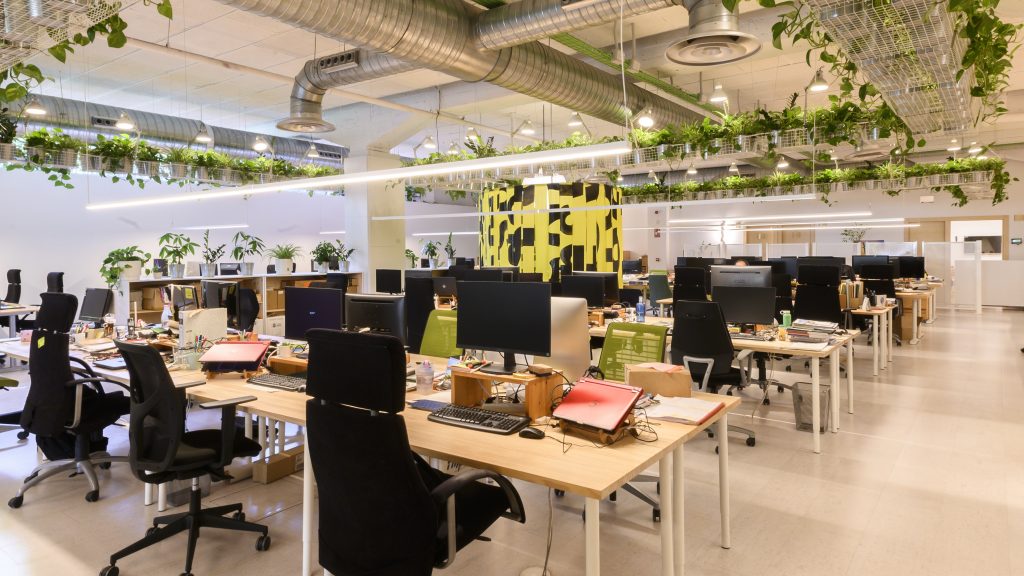
GUEST ARTICLE: How will the new office look post pandemic?
This guest article sees James Scully, Managing Director at Quadrant, look at how our offices could look in the wake of the COVID-19 pandemic.
“Recent months have seen many people embracing a different kind of office: the home. But as we return to shared spaces, focus must shift from temporary adaptation to how work practices and places can be effectively reconfigured for the post-pandemic future.
Ensuring lasting success won’t just be about quick fixes. While lockdown has brought some important lessons about dealing with the fast-evolving business climate — such as the benefits of greater work flexibility and virtual conferencing — there is a need for longer-term solutions to provide better environments for our more ‘conscious’ workforces.
Functionality and flexibility are key, but so are wellbeing and safety. This means every component of design must be managed with care, including building and surfacing materials – with flooring having an especially vital part to play.
No overnight building revolution
Despite causing huge disruption, COVID-19 isn’t destined to completely revolutionise the way we work. Firstly, contrary to predictions about their imminent disappearance, the global crisis has shown how much people miss going to physical places, including workplaces — with over half of UK workers having already returned to their desks.
Secondly, many concepts now dominating discussions about office development were already gaining traction pre-pandemic; including shared workspaces and incorporating elements of biophilic design into office environments.
As a result, future workspaces may not be as radically different many anticipate, but they will see changes that enhance everyday efficiency and value; especially when it comes to improving worker health, happiness, and productivity.

Maintaining a social distance
With social distancing measures due to continue, the most prominent adjustments to office planning will be in spatial outlining and navigation.
Workplace design needs to take into account factors that are now crucial to ensuring employee safety — including density, proximity, and traffic flow — and better flooring decisions will be vital to achieving that.
Of course, using flooring to help direct movement and define zones isn’t new. But the main difference now is design features must be more noticeable to help protect individuals; particularly if offices regularly welcome visitors who aren’t familiar with internal risk limitation procedures, such as one-way systems or designated desks for external users.
Design should therefore centre on enabling streamed flow and making the distinct purpose of environments instantly clear.
For instance, that might involve layering different patterns to assist with wayfinding through different office areas, from the boardroom to the kitchen.
Or through the use of contrasting colours which can immediately mark which modules are intended for specific teams or activities.
The added bonus being that this approach goes some way towards limiting the requirement for divisions such as cubicles and wall partitions that can heighten the sensation of isolation.
Retaining the comforts of home
Eager as workers may be to resume normal office life — particularly socialising with colleagues — the sharp transition they face shouldn’t be underestimated.
For those who have spent half the year logging in from home, re-entering corporate environments is a big change that has the potential to leave them feeling uprooted and anxious.
Once more, intelligent design has considerable capacity to make the journey back to work smoother. In fact, according to a report highlighted by CMI Workplace, strong office design in general can make employees up to 33% happier at work.
Over the last few years, many residential concepts have started migrating to the commercial world; including nature-based biophilic, minimalist Scandinavian, and Hygge design.
Now, there is an opportunity to tap these styles as a simple and effective way of introducing reassuring homeliness to office environments.
For instance, integrating Danish lifestyle elements associated with Hygge — focused on warmth and winter survival — can be as simple as adding carpeting in a muted neutral colour palette.
Similarly, office floors can immediately reflect sleek Scandinavian design by using home-inspired cork or wood-aesthetic luxury vinyl tile (LVT) flooring, while adopting a mix of materials can also provide visual cues that promote relaxation in break out areas.
Increasing focus on minimal impact
The dual considerations of wellbeing and sustainability are increasingly integral for every business. Amid the current crisis, a stronger focus on hygiene is paramount to safeguard both employee health and productivity; and using the right sustainable resources can be key in achieving this goal.
That’s not to mention allowing organisations to reduce waste, preserve energy, create a generally healthier work environment, and save money.
When selecting flooring, it’s critical to keep multiple criteria in mind. Materials must play their part in minimising negative impact on employee health and the environment, in addition to meeting robust green benchmarks; such as being free from volatile organic compounds (VOCs) and complying with strict UK and EU indoor air quality standards.
LVT, for instance, is easy to clean, durable and offers protection against bacteria. Meanwhile, cork has a raft of health and sustainable plus points: not only carbon negative — retaining more CO2 than it emits — but also capable of reducing acoustic noise by up to 50%.
Little wonder cork was the first choice for Greenpeace when picking the right flooring for its new ecological HQ in Madrid.
But as the convergence of eco-friendly and wellbeing agendas fuels a more holistic, human-centred approach to design, it will also be important to be more discerning about suppliers.
To be specific, that will mean prioritising those who can demonstrate their commitment through environmental accreditation and standards — such as Building Research Establishment Environmental Assessment Method (BREEAM) — attention to resource management and use of latest sustainable technologies.
The great working-from-home experiment won’t mean the end of the office, but its influence over attitudes to how we work will have a lasting impact.
As COVID-19 accelerates pre-existing trends and changes priorities for designers, architects, and employers, the way workplaces look is on course for small yet significant changes.
With more demand for safe, comfortable and responsible environments will come a new era of flexibility, innovation, and enhanced performance throughout the design, specification and building process.”
Latest news

29th April 2025
Senior pledges to ‘bee’ part of the solution with new biodiversity initiative
Senior Architectural Systems has installed its first on-site beehive, marking another step forward in its commitment to sustainability and biodiversity.
Posted in Articles, Building Industry News, Building Products & Structures, Building Services, Curtain Walling, Doors, Glass, Glazing, Innovations & New Products, news, Restoration & Refurbishment, Retrofit & Renovation, Sustainability & Energy Efficiency, Walls, Windows
29th April 2025
West Fraser range delivering key benefits for South-East carpentry company
An experienced carpenter and building site manager who has recently set up his own company is using high performance panel products from the West Fraser range.
Posted in Articles, Building Industry News, Building Products & Structures, Building Systems, Case Studies, Garden, Restoration & Refurbishment, Retrofit & Renovation, Sustainability & Energy Efficiency, Timber Buildings and Timber Products
29th April 2025
CPD Courses Available Online From Ecological Building Systems
Ecological Building Systems, a leading supplier of natural building products for sustainable construction, has revealed its comprehensive CPD programme for the year ahead.
Posted in Articles, Building Industry Events, Building Industry News, Building Products & Structures, Building Services, Continuing Professional Development (CPD's), Information Technology, Innovations & New Products, Insulation, Restoration & Refurbishment, Retrofit & Renovation, Seminars, Sustainability & Energy Efficiency, Training, Walls, Waste Management & Recycling
29th April 2025
WindowBASE launches new prospect databases at FIT Show
Visit WindowBASE at the FIT Show to see first-hand how it helps companies find new customers – the company is launching an easy-to-use, intuitive platform on Stand G16 at the NEC Birmingham from 29th April – 1st May.
Posted in Articles, Building Industry Events, Building Industry News, Building Products & Structures, Building Services, Doors, Exhibitions and Conferences, Glass, Glazing, Information Technology, Innovations & New Products, Posts, Publications, Research & Materials Testing, Restoration & Refurbishment, Retrofit & Renovation, Windows
 Sign up:
Sign up: